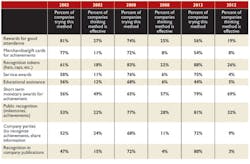Motivating Employees: What Works? What Doesn’t Work?
It is not surprising that our latest survey of how 427 companies are persuading workers to improve productivity in today's uncertain economy finds growing numbers of employees now are motivated primarily by basic provisions of employment – job security and pay. They are only secondarily influenced by employers' efforts using the latest "employee engagement" fad.
In 2002, well before the Great Recession, we visited 427 manufacturers nationwide – 32 being foundries and diecasters – asking executives how they were trying to persuade employees to make greater on-the-job efforts, and which ways were most effective. ("Improving Your Profitability Pattern," Foundry Management and Technology, September 2002.) We repeated the survey five years later ("Work Harder, Work Smarter, to Motivate Your Employees," FM&T, November 2007), as the Great Recession was just starting, and again in early this year, during its sullen recovery. Trends in the metalcasting industry's efforts to persuade employees to improve on-the-job performance — and the effectiveness of these efforts — are shown in the following chart.
The chart documents five important facts:
- First, due to the 2008-2009 recession's impact, workers now focus on basic rewards (job security) and economic motivators (the value of their paychecks.)
- Second, short-term economic motivators like Gainsharing that match employees' short-term horizons had the greatest impact on productivity.
- Third, employees expect "extra" rewards for any "extra" efforts asked of them. Fulfilling these expectations is critical to the long-term success of any new initiative for boosting productivity and eliminating waste. If the "extra" is absent, employee cooperation is short-lived.
- Fourth, although many employers have reemphasized "engagement" efforts to influence employees' behavior, employees considered these to be of only secondary importance. Economics remained their priority.
- Fifth, jargon has gone steroidal. Efforts to improve worker performance were called "motivators" in 2002 and "involvement efforts" in 2007. By early 2012 these efforts had become "engagement." "Engagement" has morphed now into the "science of engageonomics," at least by those promoting the latest jargon and trying to sell their version of it.
Don't misunderstand: there are advantages to jargon. It gives those using it an aura of omniscience. Because it is not well defined and its goals are vague, jargon can mean anything its practitioners say it means, and the positive results they claim will be just as specious as is their jargon.
As to jargon's disadvantages, one can recall marketing guru John Sculley, recruited by Steve Jobs to run Apple. In 1991, the Wall Street Journal reported Sculley declaring, "… We have a new agenda … empowering individuals." Apple's mid-1990s near-death experience let the world know the effectiveness of Sculley's vague empowerment efforts.
Motivators that work
Eschewing jargon, our surveys show the obvious: recent events have affected workers' attitudes and changed how to influence their behavior with effectiveness. The Great Recession devastated Americans'pocketbooks, and the continuing impact of high gas prices on consumer spending isn't helping either. Unless Washington faces up to its fiscal crisis, the non-partisan Congressional Budget Office reports the U.S. will fall off a "fiscal cliff" early next year, triggering another recession.
Consumer confidence and workers' attitudes remain shaken. With today's concerns and tomorrow's uncertainties, metalcasting executives have learned that short-term, transparent economic motivators paired with supporting communications efforts are most effective at persuading employees to boost productivity and cut per-unit costs. Using them improves worker performance, reduces employee insecurities, bolsters future job security, and shows workers they can control their own destinies — the smarter they work, the better their future will be.
Non-economic motivators have a long history, always aiming to bolster workers' pride. These include preferred parking places, service awards and special recognition for those that reach certain milestones, service lunches and Christmas parties. Although they offer little positive motivation, their absence or curtailment is resented, which perhaps explains why, as the chart shows, companies continue these efforts although they question their effectiveness.
These efforts should be continued because they sustain employee morale. However, they have little direct effect on workers' daily effort or on-the-job behavior.
Economic Rewards
Most executives expect economic rewards for their own better "performance". Such performance might be seen in improved company profitability, increased per-share earnings, or higher stock prices. As the 2002-2012 responses show, astute foundry and diecaster executives have learned that what is good for the goose is good for the gander, and are extending economic incentive programs deep within their organizations.
Profit sharing plans are widespread, as are merit raises and discretionary year-end bonuses. Unfortunately, many merit raise programs are disguised general increases (if everybody receives the same "merit raise," what's the incentive?) And, most discretionary year-end bonuses are based on ill-defined, illusory criteria.
Many executives think their discretionary year-end bonus programs are highly effective. Unfortunately, vague programs produce vague results, rather than specifically focusing employees on daily performance. Year-end bonuses are popular – nobody says no to them – but, when asked, few employees can answer: "What specifically did you do to earn your year-end bonus, and why did you earn the amount you received?"
Economic motivators that affect day-to-day behavior are effective if they are easy to understand and match the short-term horizons of the workers whose efforts they are designed to influence. Few blue-collar workers have a "line of sight" long enough to equate what they do today with an ill-defined year-end raise or bonus, to say nothing of a profit-sharing plan paid 20 years from now on retirement.
Casting industry executives said pay-for-performance programs with frequent payouts coupled with vigorous supporting communications efforts are the most effective at "engaging" employees to focus on daily productivity requirements, and reinforcing their desire to cooperate with management to eliminate waste. That short-term rewards are effective is not surprising, not when Wal-Mart reports the number of customers living paycheck-to-paycheck "remains pronounced," due to "continuing economic pressures." (Wall Street Journal, Aug. 16, 2012.) Perhaps this need for immediacy explains why, as the chart again shows, companies feel that deferred reward programs are becoming less effective.
Employees expect "extra" rewards when they make "extra" efforts, executives said. Recognizing this is critical for the success of any productivity program a company starts, like "lean manufacturing." In the past, the successes of similar plans like Quality Circles, Total Quality Management, or Statistical Process Quality Control frequently were brief. When workers asked "what's in it for me?" to make extra efforts, they received vague answers. Based on the Toyoda System for eliminating waste, Lean emphasizes the "5 S's," the last being Sustainability. When the extra reward was absent, employee cooperation was unsustainable, and the Lean initiative soon petered out.
The forgotten side of Gainsharing
As the chart shows, Gainsharing was the most effective short-term motivator. Gainsharing is a group pay-for-performance program under which employee performance is quantified and assigned a dollar value. The value of their improvement is split among them. So, for every dollar paid out to workers in Gainshare bonuses earned by specific measures of short-term performance, a metalcaster saves a like amount in higher productivity, better quality, and improved safety. Because Gainsharing plans provide pay-offs earned on a short-term basis (often monthly), employee notions that Gainsharing is an entitlement are negated.
Many executives think workers respond automatically to earn a Gainshare bonus. They are wrong: effective Gainsharing plans do require "engageonomics," i.e., vigorous communications programs to engage workers to cooperate in improving production efficiency and product quality.
Especially now, employees welcome opportunities to earn extra money. Although no metalcasting executive we surveyed singled out communications as a motivational tool, it is the root of employee satisfaction. With Gainsharing, frequent communications to employees regarding quality and productivity "engaged" them to do their best to keep their company competitive and their jobs secure. Workers respond to the opportunity to contribute. When they see management honestly soliciting ideas to work smarter by identifying and removing impediments to their performance and then responding to them, workers realize their efforts are important – and valued. Call it motivation, involvement, or engagement … the process is effective
The subtleties of persuading employees to make increased efforts are lost on many metalcasting executives, who focus on data to check costs while ignoring the importance of good employee communications.
Most of these executives have little time to debate what is effective — economic or non-economic motivators. They need immediate, practical answers on how to influence worker behavior so their goals of high productivity and better profit margins can be reached. The chart shows most executives use both ways: first, providing group economic rewards to employees working as a team to help achieve company productivity and profitability goals; and second, using effective "engagement efforts" (communications programs) to reinforce the economic motivators and create a sense of unity.
Injured by the Great Recession of 2008-2009, scarred by the anemic recovery, and fearful of the future, today's employees are oblivious to buzz words but can be convinced to try their best when they find their rewards in their paychecks. What are you doing to give them the rewards they value?
Dr. Imberman is president of Imberman and DeForest, Inc., management consultants specializing in employee audits and communications, Gainsharing Plans, and other pay-for-performance programs. Contact him at tel. 847-733-0071 or [email protected].
About the Author
Woodruff Imberman
Ph.D.
Dr. Imberman is the president of Imberman and DeForest Inc., management consultants specializing in improving managerial effectiveness, supervisory efficiency, and employee productivity through management and supervisory training, workforce audits, Gainsharing Plans, and other pay-for-performance programs. He has written numerous articles on these subjects.

